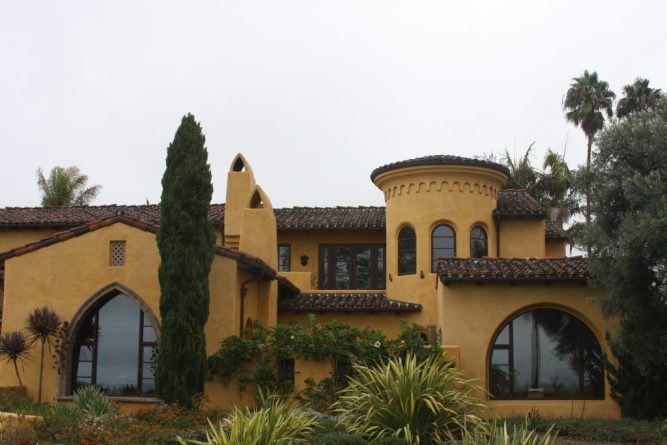
Why should I use stucco over other products?
Stucco is the leading all around exterior finish. Stucco is very efficient and gives you the best value, dollar for dollar, that you can apply on your home or commercial building. Just think a sandblast and re-stucco job will cover all the exterior of your home for just a few thousand dollars. While doing so, we can remove all those old window patches, nicks, dings, stains, scratches, holes, discolorations, you name it. We can even change the texture. Stucco is a tried and true finish with a proven long-term and well documented history. Stucco provides countless textures, beauty, durability, and it also has a one hour fire rating. The fire resistance properties of Portland cement stucco must be an obvious choice for your home or commercial building. After all the California wild fires we experienced in the last few years, new building codes are requiring closed in eaves with cement stucco. This is because the week point on many of the houses that caught fire was under the wood eaves and not through the stucco.
Does stucco fade over time?
Cement stucco uses iron oxide pigments to achieve its color. These inorganic minerals give the colors a rich and natural look. Integral colored exterior stucco is a mechanically blended compound of Portland cement, hydrated lime, sand aggregates, and iron oxide pigments. Since the stucco is internally colored, it never needs painting. If you think about it, all stucco is made up of dirt, and dirt never fades. Red bricks and tile roofs also use the same minerals to make their colors. They also have a very low fade factor. Stucco cement products fade approximately 1% to 3% in 20 years. Depending on the color most paint products will fade about 50% in 5 to 8 years. Stucco is very durable when applied correctly, cement stucco is a tough fire resistant material that will not peal and resists fading.
How do I maintain my new stucco job?
Minimal care will keep your stucco looking attractive for many years. With simple maintenance, stucco will last for nearly a life time, just the act of washing with water once every six months will keep the surface clean and colors bright. A few fundamental precautions should be considered to improve the long term performance of your stucco. First, do not allow spray from your lawn and garden sprinkler system to come into contact with your stucco walls. Constant dampness and the spray pattern will deteriorate the stucco system. Second, minerals carried in the water may also be left behind and can discolor the stucco when the water evaporates. Third, your gardener’s weed whip, if your grass grows up to the base of your stucco wall and your gardener weed whips the base of the wall every week, you’ll soon have stucco problems.
Cement Stucco FAQ
Taking Care of Your Cement Re-Stucco
Stucco is one of the most durable finishes you will find on buildings. It is made from all-natural mineral materials; painting will never be necessary if cared for properly. Over time, stucco benefits from an occasional cleaning to remove airborne dust or other atmospheric matter. Occasionally, a lawn mower or garden tool might chip a corner, or some other minor repair might be needed. The following information will help you to take care of your stucco finish
